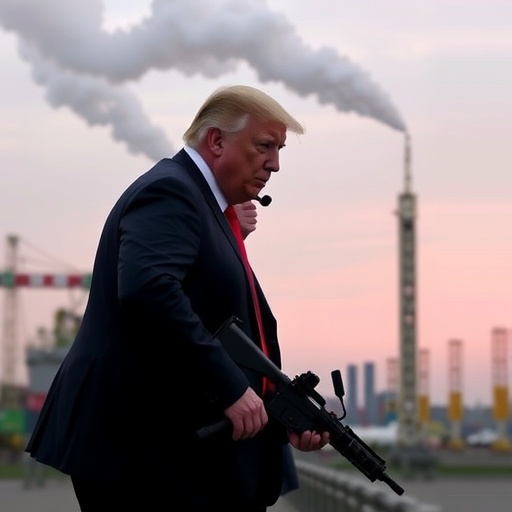Trump Administration Hits Russian Oil Sector with Fresh Sanctions as Ukraine War Intensifies
In a bold escalation of economic warfare, the Trump administration announced sweeping new sanctions on major Russian oil companies on Wednesday, targeting entities like Rosneft and Gazprom Neft just days after a highly anticipated peace summit between Ukraine and Russia collapsed without agreement. This move, aimed at crippling Moscow’s war funding machine, comes as the Ukraine war enters its third grueling year, with frontline battles raging and civilian casualties mounting. President Trump, in a White House address, declared, “We’re turning off the spigot to Putin’s oil empire—America won’t stand by while aggression pays dividends.”
The sanctions, detailed in an executive order signed earlier today, prohibit U.S. firms and financial institutions from engaging in any transactions involving Russian oil exports valued over $10 million. This includes secondary sanctions on third-party nations that facilitate such deals, potentially isolating Russia’s energy sector from global markets. Analysts estimate these measures could slash Russia’s oil revenues by up to 20% in the coming months, a critical blow given that oil accounts for nearly 40% of Moscow’s federal budget.
The timing couldn’t be more pointed. The abandoned peace summit, brokered by neutral parties in Geneva last week, was meant to discuss ceasefires and humanitarian corridors but derailed amid mutual accusations of bad faith. Ukrainian President Volodymyr Zelenskyy blamed Russian intransigence, stating in a Kyiv press conference, “Moscow’s refusal to withdraw forces shows their true intentions—total domination.” Russian officials, in turn, accused the West of sabotaging talks to prolong the Ukraine war for geopolitical gain.
New Sanctions Zero In on Rosneft and Gazprom’s Global Operations
The core of the Trump administration’s strategy focuses on two behemoths of the Russian oil industry: Rosneft, the world’s largest publicly traded oil company, and Gazprom Neft, the oil arm of Russia’s state-controlled gas giant. Under the new sanctions, any U.S.-based entity dealing with these firms risks severe penalties, including asset freezes and exclusion from the U.S. financial system. “This isn’t just about oil; it’s about starving the beast that fuels tanks and missiles in Ukraine,” said Treasury Secretary Janet Yellen in a briefing to Congress.
Rosneft, which produced over 5.5 million barrels per day in 2023, has long been a linchpin in Russia’s export strategy, shipping crude to buyers in China, India, and Europe despite previous Western restrictions. The sanctions build on earlier measures from 2022 but introduce novel “shadow fleet” clauses, targeting the opaque network of tankers Russia uses to evade tracking. According to a report from the International Energy Agency (IEA), this fleet has enabled Russia to maintain oil exports at 7.5 million barrels per day—down from pre-war peaks but still resilient.
Gazprom Neft faces similar scrutiny, with its Arctic drilling operations now off-limits to Western technology providers. A company spokesperson in Moscow downplayed the impact, claiming, “We have diversified partners and will adapt.” However, internal leaks reported by Reuters suggest potential production halts in key Siberian fields, where U.S. equipment is irreplaceable. These targeted strikes are designed to minimize global supply disruptions while maximizing pain for Moscow, experts say.
To illustrate the breadth, the sanctions also hit smaller players like Lukoil and Slavneft, imposing a blanket ban on their use of U.S. dollars in international trade. This could force a costly pivot to alternative currencies like the yuan, further straining Russia’s already sanctioned banking sector.
Peace Summit Collapse: From Hope to Hostility in Geneva
The unraveling of the Geneva peace summit marks a pivotal setback in diplomatic efforts to end the Ukraine war. Scheduled for mid-October, the talks brought together delegations from Kyiv, Moscow, and mediators from Turkey and Switzerland. Initial sessions showed promise, with agreements on prisoner swaps and grain export routes through the Black Sea. But by day three, negotiations fractured over Russia’s demand for recognition of annexed territories in Donetsk and Luhansk—demands Zelenskyy labeled “non-starters.”
A timeline of events reveals the rapid deterioration: On October 10, Russian Foreign Minister Sergey Lavrov arrived with a 12-point proposal that included demilitarization of Ukraine’s borders. Ukrainian counterparts countered with calls for full Russian troop withdrawal and reparations estimated at $500 billion for war damages. By October 12, shouting matches erupted in side rooms, and the summit chair, Swiss diplomat Didier Burkhalter, suspended proceedings, citing “irreconcilable positions.”
Behind the scenes, intelligence sources indicate U.S. pressure played a role. Trump administration officials reportedly urged Zelenskyy to hold firm, fearing any concessions would embolden Moscow. “We advised caution—peace can’t come at the cost of sovereignty,” a State Department official told reporters anonymously. The collapse has reignited calls for more military aid to Ukraine, with the U.S. Congress debating a $60 billion package that includes advanced missile systems.
For ordinary Ukrainians, the failed talks are a bitter pill. In Kharkiv, resident Maria Kovalevska, whose home was destroyed in a recent drone strike, shared her frustration: “We pinned hopes on Geneva, but now it’s back to bombs. When does this end?” The summit’s failure underscores the deepening divide, with trust eroded by over two years of brutal conflict that has claimed more than 500,000 lives on both sides, per UN estimates.
Global Energy Ripples: Oil Prices Spike Amid Sanction Fears
The announcement of these Trump-led sanctions on Russian oil has sent shockwaves through international energy markets. Brent crude futures surged 5% to $85 per barrel within hours, reflecting investor anxiety over potential supply squeezes. Europe’s reliance on alternative sources is being tested; Germany, once a major importer of Russian gas, has accelerated LNG imports from the U.S. and Qatar, but analysts warn of winter shortages if Russian flows dip further.
In Asia, the impact is mixed. India, which has boosted Russian oil purchases to record levels—importing 1.8 million barrels daily in 2023—now faces dilemmas. New Delhi has urged Washington for exemptions, citing energy security needs, but Trump dismissed such pleas: “No free rides for those funding the Ukraine war machine.” Chinese state media, meanwhile, vowed to support Moscow through bilateral deals, potentially shielding some Russian exports from the sanctions’ bite.
Statistics paint a stark picture: Russia’s oil sector generated $320 billion in 2022 revenues, funding 45% of its military spending. With sanctions in place, the IEA projects a 1.5 million barrel-per-day drop in global supply by Q1 2025, pushing prices toward $100 if OPEC+ doesn’t intervene. U.S. producers stand to gain, with shale output expected to rise 10% as domestic prices climb.
Environmental advocates see a silver lining. Groups like Greenpeace argue the measures could accelerate the shift to renewables, noting that curbing Russian oil aligns with global decarbonization goals. “This is a forced pivot away from fossil fuels that harm both the planet and peace,” said campaigner Anna McClean.
Moscow’s Defiant Response and Warnings to the West
From the Kremlin, the reaction to the new sanctions has been one of unyielding defiance. President Vladimir Putin, in a nationally televised address, accused the Trump administration of “economic terrorism” aimed at prolonging the Ukraine war. “These sanctions won’t break us; they’ll only strengthen our resolve and partnerships with the Global South,” Putin stated, referencing growing ties with BRICS nations.
Moscow has retaliated swiftly, announcing export curbs on rare earth metals critical for U.S. tech industries and hinting at weaponizing its remaining energy leverage. Russian Deputy Prime Minister Alexander Novak warned that further restrictions could lead to “unpredictable consequences” for European allies, including potential gas shutoffs despite the Nord Stream sabotage aftermath.
Internationally, responses vary. NATO Secretary General Jens Stoltenberg praised the U.S. move as “vital support for Ukraine’s defense,” while French President Emmanuel Macron called for a balanced approach to avoid alienating neutral players. In the U.N. Security Council, Russia vetoed a resolution condemning its actions in Ukraine, further isolating itself diplomatically.
Within Russia, state media has framed the sanctions as a badge of honor, boosting nationalist sentiment. Polls from the Levada Center show 70% of Russians view the West as an adversary, up from 55% pre-war. Yet, economic cracks are showing: Inflation hit 8.5% last month, and the ruble weakened 3% against the dollar post-announcement.
Path Forward: Escalating Pressures and Hopes for De-Escalation
As the dust settles on these sanctions, the Ukraine war’s trajectory hinges on multifaceted pressures. The Trump administration’s strategy signals a harder line, with plans for quarterly reviews to tighten the noose on Russian oil if Moscow doesn’t engage in good-faith talks. Aid to Ukraine is ramping up, including $10 billion in energy infrastructure support to wean Kyiv off Russian dependencies.
Looking ahead, experts foresee intensified cyber and hybrid threats from Moscow, potentially targeting U.S. grids or allies’ pipelines. Diplomatic channels remain open; backroom talks via Qatar could revive summit efforts by spring. For global markets, the wildcard is OPEC’s November meeting, where production hikes might offset sanction-induced volatility.
Ultimately, these measures underscore a high-stakes gamble: Will economic isolation force Putin to the table, or entrench the Ukraine war further? As winter looms, with Ukrainian forces holding key lines near Kherson and Russian advances stalling in the east, the world watches for glimmers of resolution amid the gathering storm.









